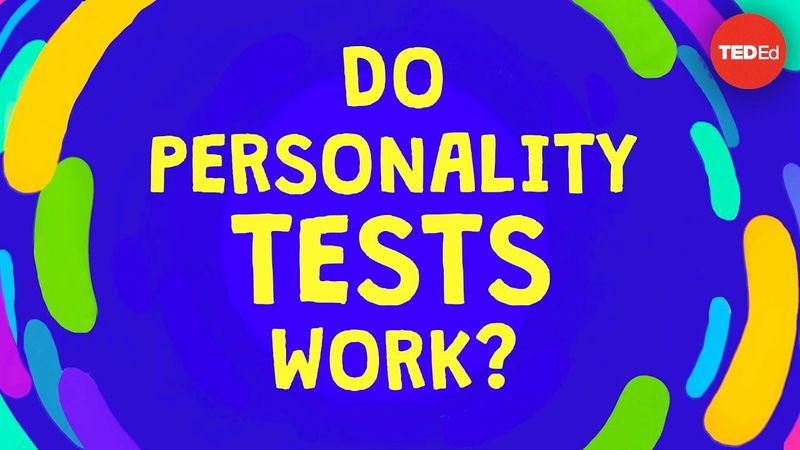Ep. 9 | แบบทดทดสอบบุคลิกภาพบอกบุคลิกภาพได้จริงหรือเปล่า? Part 2/2
👉
ในตอนที่เล่า (Ep. 8) เราได้เล่าถึงเหตุผล 3 ข้อที่สนับสนุนความเชื่อที่ว่า แบบทดสอบบุคลิกภาพไม่สามารถประเมินบุคลิกภาพได้จริง ตามวิดีโอเรื่อง Do personality tests work? (https://youtu.be/lN7Fmt1i5TI) ของ TED-Ed พร้อมกับงานวิจัยที่เกี่ยวข้อง
ในครั้งนี้ เราจะพูดถึง 3 เหตุผลที่เหลือซึ่งถูกหยิบยกขึ้นมาในวิดีโอ พร้อมข้อสรุปทั้งหมด
(ที่มา: TED-Ed: https://youtu.be/lN7Fmt1i5TI)
.
🪟 1. เหตุผลที่ 4: คะแนนไม่สะท้อนให้เห็นความแตกต่างระหว่างบุคคลในชีวิตจริง
.
🤔 1.1. เหตุผล
ในวิดีโอระบุว่า คนที่มีคะแนนบุคลิกภาพใกล้เคียงกันกลับถูกจัดอยู่ในบุคลิกภาพคนละประเภท (เช่น คนหนึ่งเป็น extrovert ส่วนอีกคนเป็น introvert) ซึ่งแสดงให้เห็นว่า แบบทดสอบบุคลิกภาพไม่ไว (sensitive) ต่อความแตกต่างระหว่างในโลกจริง (เพราะถ้าไวจริง จะต้องสามารถจำแนกคนได้อย่างถูกต้อง)
.
💡 1.2. ข้อมูลจากงานวิจัย
บุคลิกภาพสามารถมองได้ 2 แบบ
(1) type (ประเภท) ซึ่งมองว่า คนสามารถถูกจัดเป็นประเภทต่าง ๆ ที่แยกขาดออกจากกันได้ (เช่น introvert-extrovert บอกว่า แบ่งคนได้เป็น 2 ประเภทที่มีลักษณะแตกต่างกันอย่างสิ้นเชิง คือ มีโลกส่วนตัวสูง และ ชอบเข้าสังคม)
(2) trait (ลักษณะ) ซึ่งมองว่า คนเรามีชุดมิติ (dimension) ที่แตกต่างกันไป (เช่น extroversion ที่บอกว่า คนมีระดับที่จะเข้าหาสังคมแตกต่างกันไป ซึ่งสามารถมีคนที่อยู่ตรงกลางได้)
ในปัจจุบัน แบบทดสอบส่วนใหญ่ที่ได้รับการยอมรับทางวิชาการส่วนใหญ่ (เช่น NEO-PI, McCrae et al., 2005; Hogan Personality Inventory, Hogan & Hogan, 2007) ใช้มุมมองแบบ trait มากกว่า type ด้วยเหตุผลหลัก 2 ข้อ
(1) งานวิจัยที่พยายามค้นหา type ของบุคลิกภาพให้ผลที่เหมือนกัน (เช่น Costa et al, 2002; Gerlach et al., 2018) โดยแต่ละงานระบุจำนวน type ไม่เท่ากัน ทำให้ขาดความเชื่อมั่นว่า คนสามารถถูกจัดกลุ่มเป็นประเภทได้
(2) เมื่อเทียบการประเมินบุคลิกภาพแบบ type และ trait แล้ว, การประเมินแบบ trait ให้ข้อมูลในการอธิบายพฤติกรรมมนุษย์ได้มากกว่า (Ashton & Lee, 2009) ซึ่งทำให้การประเมินแบบ trait มีประโยชน์ในการทำนายพฤติกรรมได้มากกว่าแบบ type
McCrae และ Costa (1989) นักจิตวิทยาที่คิดค้น NEO-PI ให้ความเห็นว่า MBTI ซึ่งวิดีโอได้ยกเป็นตัวอย่าง เป็นแบบทดสอบที่แปลก เพราะใช้การประเมินแบบ type แทนแบบ trait
นอกจากนี้ จากการศึกษา McCrae และ Costa ไม่พบข้อมูลสนับสนุนว่า MBTI สามารถแบ่งคนเป็นประเภทต่าง ๆ ได้ตามทฤษฎี ซึ่งหมายความว่า การแปลความของ MBTI ที่แบ่งคนเป็น 16 ประเภท เป็นการลดทอนแทนการเพิ่มข้อมูลในการอธิบายความแตกต่างระหว่างบุคคลลง
จึงไม่น่าแปลกใจที่ในวิดีโอบอกว่า คนที่ได้คะแนนใกล้เคียงกันอาจถูกจัดอยู่ในคนละประเภท เพราะการแปลผลแบบ type จะลดทอนข้อมูลที่ทำให้ความแตกต่างในโลกจริงถูกมองข้ามไป
เช่น A ได้คะแนน 49/100 และ B ได้ 51/100, A อาจจะถูกจัดว่าเป็น introvert ในขณะที่ B เป็น extrovert (ถ้าจุดตัดอยู่ที่ 50) แม้ว่าทั้งสองจะมีคะแนนและพฤติกรรมในชีวิตจริงที่ไม่แตกต่างกันอย่างมีนัยสำคัญ
อย่างไรก็ตาม ปัญหาดังกล่าวเกิดขึ้นเฉพาะกับแบบทดสอบบุคลิกภาพแบบ type ที่เป็นส่วนน้อย (เช่น MBTI) ดังนั้นการที่จะบอกว่า แบบทดสอบบุคลิกภาพทั้งหมด (ทั้ง type และ trait) ไม่สามารถประเมินบุคลิกภาพได้ จึงเป็นการกล่าวเกินจริง
(ที่มา: TED-Ed: https://youtu.be/lN7Fmt1i5TI)
.
🫥 2. เหตุผลที่ 5: นิยามบุคลิกภาพเปลี่ยนแปลงตลอดเวลา
.
🤔 2.1. เหตุผล
ในวิดีโอได้ยกตัวอย่าง introvert-extrovert ซึ่ง Carl Jung นักจิตวิทยาชาวสวิสเซอร์แลนด์เป็นคนคิดค้นขึ้นมา และได้ให้นิยามว่า introvert คือ คนที่ยึดมั่นในหลักการตัวเอง ไม่โอนอ่อนต่อกระแสภายนอก ส่วน extrovert คือ คนที่สามารถปรับตัวตามสถานการณ์ได้
อย่างไรก็ตาม ในปัจจุบัน นิยามของ extroversion (ในปัจจุบัน นักจิตวิทยามักมองบุคลิกภาพเป็น spectrum และไม่นิยมเรียกคนเป็นประเภท จึงเรียกรวมว่า extroversion) มีนิยามที่แตกต่างออกไปอย่างสิ้นเชิง
นั่นคือ คนที่มี extroversion น้อย (introvert) คือคนที่มักต้องการเวลาอยู่กับตัวเองเพื่อฟื้นฟูกำลังของตัวเอง ส่วนคนที่ extroversion สูง (extrovert) คือคนที่ฟื้นฟูพลังจากการใช้เวลาอยู่กับคนอื่น
การที่บุคลิกภาพมีนิยามที่เปลี่ยนไปเรื่อย ๆ ทำให้การประเมินเป็นเรื่องยาก เพราะเราไม่สามารถรู้ได้เลยว่า สิ่งที่ประเมินออกมาคืออะไร และทำให้แบบทดสอบบุคลิกภาพไม่ได้สะท้อนบุคลิกภาพของคนจริง ๆ
.
💡 2.2. ข้อมูลจากงานวิจัย
จริงอยู่ว่า นิยามของบุคลิกภาพต่าง ๆ มีการเปลี่ยนแปลงไปตามเวลาและข้อมูลการวิจัย แต่ตั้งแต่นักจิตวิทยาให้การยอมรับ Big Five ในฐานะกรอบแนวคิดในการจัดกลุ่มบุคลิกภาพ นิยามของบุคลิกภาพต่าง ๆ ที่ใช้ก็มีความสอดคล้องกันมากขึ้น
เช่น ในปัจจุบัน เมื่อพูดถึง extroversion นักวิจัยมีความเห็นตรงกันว่า เป็นความแตกต่างระหว่างบุคคลในเรื่องการเข้าหาสังคม สิ่งเร้าภายนอก และอารมณ์เชิงบวก (DeYoung et al., 2007; Quilty et al., 2014; Soto & John, 2017; Smillie et al., 2019; Watson et al., 2015)
และนิยามนี้ก็ถูกสะท้อนอยู่ในแบบทดสอบ extroversion ต่าง ๆ เช่น NEO-PI (เช่น McCrae et al., 2005), Hogan Personality Inventory (Hogan & Hogan, 2007), HEXACO Personality Inventory (เช่น Lee & Ashton, 2004), Big Five Aspects Scales (DeYoung et al., 2007), Big Five Inventory (เช่น Soto & John, 2017), Big Five Markers (เช่น Goldberg, 1992), และ Ten-Item Personality Inventory (Gosling et al., 2003) เป็นต้น
แล้วทำไม MBTI ถึงนิยาม introvert-extrovert ที่ไม่เหมือนกับนิยาม extroversion นี้ละ?
นั่นก็เพราะว่า MBTI ซึ่งอ้างอิงทฤษฎีของ Carl Jung ที่ไม่ได้มีการอัปเดตตามการวิจัยมาเป็นเวลานาน (Grant, 2015) ทำให้เกิดความไม่สอดคล้องกับนิยาม extroversion ในปัจจุบัน
ดังนั้น จริงอยู่ที่นิยามของบุคลิกภาพมีการเปลี่ยนแปลงตามยุคสมัย แต่หลาย ๆ บุคลิกภาพมีนิยามที่เป็นสากลในหมู่นักจิตวิทยาแล้ว ซึ่งถ้าหากว่าจะยกตัวอย่าง introvert-extroversion ของ MBTI ที่อ้างอิงทฤษฎีเก่า มาเทียบกับ extroversion ในปัจจุบันที่ได้รับการอัปเดตตามงานวิจัยแล้ว เพื่อแสดงให้เห็นว่า นิยามของบุคลิกภาพมีการเปลี่ยนแปลงตลอดเวลาและไม่น่าเชื่อ จึงเป็นเหตุผลที่ฟังไม่ขึ้น
ที่สำคัญกว่านั้น คือ แม้ว่า บุคลิกภาพที่มีชื่อเรียกเดียวกันอาจมีความหมายที่ไม่เหมือนกัน แต่สิ่งที่จะบอกได้ว่า แบบทดสอบประเมินบุคลิกภาพได้หรือไม่ ขึ้นอยู่กับความตรงว่า แบบทดสอบนั้นสามารถประเมินบุคลิกภาพตามนิยามที่ถูกออกแบบมาให้ประเมินได้หรือไม่ ถ้าได้ ก็เป็นหลักฐานหักล้างว่า ความเชื่อที่ว่าไม่สามารถประเมินได้
(ที่มา: TED-Ed: https://youtu.be/lN7Fmt1i5TI)
🧓 3. เหตุผลที่ 6: บุคลิกภาพเปลี่ยนแปลงตามอายุ
.
🤔 3.1. เหตุผล
เหตุผลสุดท้ายที่บอกว่า แบบทดสอบบุคลิกภาพไม่สามารถประเมินบุคลิกภาพได้ คือ ข้อมูลจากงานวิจัยที่บอกว่า บุคลิกภาพเปลี่ยนแปลงตามอายุ
การที่บุคลิกภาพมีการเปลี่ยนแปลง ทำให้การประเมินเป็นเรื่องยาก เพราะหนึ่งในสมมุติฐานในการประเมินลักษณะทางจิตใจ คือ สิ่งที่ต้องประเมินจะต้องมีความเสถียร (stability) ไม่เปลี่ยนแปลงมากจนเกินไป ถ้าสิ่งที่แบบประเมินถูกออกแบบมาให้ประเมินมีการเปลี่ยนแปลงตามเวลา เราจะไม่สามารถบอกได้ว่า คะแนนที่ได้จากแบบประเมิน เป็นสิ่งที่เราต้องการวัดจริง ๆ หรือไม่
ดังนั้น การที่บุคลิกภาพมีการเปลี่ยนแปลงตามช่วงอายุ ทำให้แบบทดสอบบุคลิกภาพไร้ความหมายโดยสิ้นเชิง
.
💡 3.2. ข้อมูลจากงานวิจัย
เป็นความจริงว่า งานวิจัยแสดงให้เห็นว่าบุคลิกภาพมีการเปลี่ยนแปลงตามอายุ เช่น เมื่ออายุมากขึ้น คนส่วนใหญ่มักมี conscientiousness (ความขยัน) และ extroversion (การเข้าหาสังคม) สูงขึ้น (Roberts et al., 2006)
ถ้าเป็นอย่างนี้แล้ว แสดงว่า แบบทดสอบบุคลิกภาพไม่สามารถบอกบุคลิกภาพที่แท้จริงได้?
ไม่ซะทีเดียว แบบทดสอบยังสามารถใช้งานได้อยู่ เพราะ
(1) คะแนนบุคลิกภาพมักจะคงที่ในช่วงวัยผู้ใหญ่ ซึ่งทำให้แบบทดสอบสามารถใช้กับผู้ใหญ่ได้ (เช่น ทดสอบบุคลิกภาพเพื่อคัดเลือกเข้าทำงาน)
(2) แม้ว่าจะมีการเปลี่ยนแปลง แต่การจัดอันดับยังคงเหมือนเดิม (Roberts & DelVecchio, 2000) นั่นคือ A มีความขยันกว่า B เมื่อตอนเป็นเด็ก เมื่อโตขึ้น แม้ว่าคะแนนทั้งคู่จะเปลี่ยนไป แต่ A ก็จะยังมีความขยันมากกว่า B อยู่ดี
(3) นอกจากนี้ การเปลี่ยนแปลงของบุคลิกภาพตามอายุ ไม่ได้เกิดขึ้นในช่วงข้ามคืน (ไม่มีเด็กคนไหนที่วันหนึ่งขี้เกียจ แต่วันเกิดกลายเป็นคนขยันขึ้นมา เว้นแต่จะมีอะไรจูงใจ) ซึ่งทำให้การประเมินบุคลิกภาพในช่วงเวลาสั้น ๆ กับคนที่ยังอยู่ในวัยเด็กและวัยรุ่นเป็นไปได้ (เช่น ในระดับสัปดาห์หรือเดือน ขึ้นอยู่กับช่วงอายุ)
ดังนั้นแล้ว แม้ว่าบุคลิกภาพจะเปลี่ยนแปลงตามวัย แต่แบบทดสอบบุคลิกภาพก็ยังสามารถประเมินบุคลิกภาพได้
(ที่มา: TED-Ed: https://youtu.be/lN7Fmt1i5TI)
.
🧑💼 4. บทสรุป + ส่งท้าย
.
😁 4.1. บทสรุป
วิดีโอ Do personality tests work? ของ TED-Ed นำเสนอเหตุผล 6 ข้อที่บอกว่า แบบทดสอบบุคลิกภาพไม่สามารถบอกบุคลิกภาพจริง ๆ ของมนุษย์ได้ ซึ่งเราได้เห็นแล้วว่า เหตุผลทั้ง 6 ไม่ได้รับการสนับสนุนจากงานวิจัย
(1) เหตุผลที่ 1 ความหลากหลายของกรอบแนวคิด: ไม่เป็นจริง เพราะนักจิตวิทยาให้การยอมรับ Big Five ว่าเป็นกรอบแนวคิดสากลแล้ว
(2) เหตุผลที่ 2 แบบทดสอบสามารถโดน “โกง” ได้: จริง แต่การโกงไม่ส่งผลต่อความตรงของแบบทดสอบ
(3) เหตุผลที่ 3 การใช้ forced-choice: แบบทดสอบที่น่าเชื่อถือส่วนใหญ่ไม่ใช้รูปแบบการตอบแบบนี้แล้ว ซึ่งการจะยกตัวอย่างจาก MBTI ที่เป็นกลุ่มน้อยไม่ใช่เหตุผลที่มีน้ำหนัก
(4) เหตุผลที่ 4 บุคลิกภาพไม่สะท้อนบุคลิกภาพในโลกจริง: เฉพาะแบบทดสอบที่ใช้มุมมองแบบ type ซึ่งเป็นส่วนน้อยเท่านั้น (เช่น MBTI)
(5) เหตุผลที่ 5 นิยามบุคลิกภาพเปลี่ยนแปลงเรื่อย ๆ: จริง แต่นักจิตวิทยาเริ่มมีความเข้าใจที่สอดคล้องกันแล้วว่า บุคลิกภาพที่ใช้ชื่อเดียวกันมีความหมายว่าอะไร
(6) เหตุผลที่ 6 บุคลิกภาพเปลี่ยนแปลงตามอายุ: จริง แต่บุคลิกภาพมีความเสถียรในผู้ใหญ่ และการเปลี่ยนแปลงตามวัยไม่ส่งผลต่อการจัดอันดับคนตามบุคลิกภาพ
.
😯 4.2. ถ้าทุกเหตุผลไม่มีงานวิจัยรับรอง ทำไมถึงมีวิดีโอนี้ขึ้นมาได้?
ส่วนตัว ผมคิดว่า ประกอบด้วย 2 เหตุผล
(1) ความเชื่อที่ไม่สอดคล้องกับงานวิจัย: คนทั่วไปมักมีความเชื่อที่ไม่ได้ตรวจสอบกับงานวิจัยเชิงลึก
เช่น ความเชื่อที่ว่า เราไม่มีกรอบแนวคิดบุคลิกภาพที่เป็นสากล ซึ่งอาจเกิดขึ้นจากการพบเห็นกรอบแนวคิดเป็นจำนวนมาก โดยไม่ได้ศึกษาอย่างละเอียดว่า กรอบแนวคิดใดที่เป็นที่ยอมรับมากที่สุด
หรือความเชื่อที่ว่า การโกงทำให้แบบทดสอบไม่น่าเชื่อถือ ซึ่งอาจเกิดจากการคิดตามหลักเหตุผลทั่วไป (common sense) และประสบการณ์จริง แต่เมื่อไม่ได้ศึกษาอย่างละเอียดก็จะไม่เห็นว่า ผลกระทบที่แท้จริงของการโกงเป็นอย่างไร
(2) แบบทดสอบที่เป็นที่รู้จักของคนทั่วไปมักเป็นแบบทดสอบที่อาจมีลักษณะทางไซโคเมทริกที่ไม่ได้คุณภาพ (เช่น มีความเที่ยง ความตรงต่ำกว่ามาตรฐาน) หรือตั้งบนทฤษฎีที่ไม่ได้เป็นที่ยอมรับทางวิชาการในวงกว้าง
ยกตัวอย่างเช่น MBTI ที่มักได้ได้รับการวิจารณ์ทั้งทางทฤษฎีและประสิทธิภาพของแบบทดสอบจากผู้เชี่ยวชาญเป็นจำนวนมาก (เช่น Chamorro-Premuzic, 2023; Grant, 2015; McCrae & Costa, 1989; Pittenger, 2005)
การที่คนทั่วไปมักรู้จักแบบทดสอบที่อาจไม่ได้มาตรฐานเป็นอันดับต้น ๆ จึงไม่น่าแปลกใจที่จะเกิดความรู้สึกไม่ไว้ใจแบบทดสอบบุคลิกภาพ
.
😇 4.3. ส่งท้าย
สิ่งสุดท้ายที่อยากทิ้งท้ายไว้ คือ แม้ว่าบางแบบทดสอบอาจขาดมาตรฐาน แต่ไม่ได้หมายความว่า แบบทดสอบเหล่านี้ไม่มีประโยชน์เลยทีเดียว
แบบทดสอบ เช่น MBTI สามารถช่วยในการสะท้อนประสบการณ์ตัวเอง เพื่อต่อยอดในการพัฒนาตัวเองได้
อย่างไรก็ตาม การใช้แบบทดสอบเหล่านี้และแบบทดสอบอื่น ๆ ควรจะทำด้วยความระมัดระมังและวิจารณญาณที่เหมาะสม
เช่น เมื่อได้ผลแบบทดสอบแล้ว เราอาจคิดทบทวนกับตัวเองว่า ผลที่เห็นตรวจกับประสบการณ์ของเราไหม และถ้าไม่ตรง เป็นเพราะอะไร เช่น ตอนทำแบบทดสอบ เราอาจจะไม่ได้ตัดใจตอบ อาจจะเข้าใจคำถามผิดไป หรืออื่น ๆ เป็นต้น
หรือถ้าเรารู้สึกไม่ชอบผลของแบบทดสอบ เพราะไม่ตรงกับสิ่งที่เราอยากให้ตัวเราเป็น เราสามารถทำอะไรบ้าง เช่น อยากเป็น introvert น้อยลง เราอาจจะตั้งเป้า ใช้เวลากับเพื่อนมากขึ้น เข้าหาคนอื่นมากกว่าปกติ เป็นต้น
เราสามารถเลือกที่จะเชื่อหรือไม่เชื่อผลของแบบทดสอบได้ แต่จะเป็นประโยชน์มากขึ้น ถ้าเราสามารถต่อยอดจากผลแบบทดสอบได้แทนที่จะหยุดอยู่แค่การตัดสินความแม่นยำของแบบทดสอบ
#psychology #individualdifferences #personality #personalitytest #personalityscale #personalityinventory #bigfive #ffm #fivefactormodel #mbti #myersbriggstypeindicator #psychometrics #psychometric #teded #ted-ed #จิตวิทยา #บุคลิกภาพ
📃 อ้างอิง
Ashton, M. C., & Lee, K. (2009). An investigation of personality types within the HEXACO personality framework. Journal of Individual Differences, 30(4), 181–187. https://doi.org/10.1027/1614-0001.30.4.181
Chamorro-Premuzic, T. (2023, August 4). Eight popular misconceptions about personality. Forbes. https://www.forbes.com/sites/tomaspremuzic/2023/08/01/eight-popular-misconceptions-about-personality/?sh=435411552b0b
Costa, P. T., Jr., Herbst, J. H., McCrae, R. R., Samuels, J., & Ozer, D. J. (2002). The replicability and utility of three personality types. European Journal of Personality, 16(SpecIssue), S73–S87. https://doi.org/10.1002/per.448
DeYoung, C. G., Quilty, L. C., & Peterson, J. B. (2007). Between facets and domains: 10 aspects of the Big Five. Journal of Personality and Social Psychology, 93(5), 880–896. https://doi.org/10.1037/0022-3514.93.5.880
Gerlach, M., Farb, B., Revelle, W., & Nunes Amaral, L. A. (2018). A robust data-driven approach identifies four personality types across four large data sets. Nature human behaviour, 2(10), 735–742. https://doi.org/10.1038/s41562-018-0419-z
Goldberg, L. R. (1992). The development of markers for the Big-Five factor structure. Psychological Assessment, 4(1), 26–42. https://doi.org/10.1037/1040-3590.4.1.26
Gosling, S. D., Rentfrow, P. J., & Swann, W. B., Jr. (2003). A very brief measure of the Big-Five personality domains. Journal of Research in Personality, 37(6), 504–528. https://doi.org/10.1016/S0092-6566(03)00046-1
Grant, A. (2015, November 17). MBTI, if you want me back, you need to change too. Medium. https://medium.com/@AdamMGrant/mbti-if-you-want-me-back-you-need-to-change-too-c7f1a7b6970
Hogan, R., & Hogan, J. (2007). Hogan Personality Inventory manual (3rd ed.). Hogan Assessment Systems.
Lee, K., & Ashton, M. C. (2004). Psychometric properties of the HEXACO personality inventory. Multivariate Behavioral Research, 39(2), 329–358. https://doi.org/10.1207/s15327906mbr3902_8
McCrae, R. R., & Costa, P. T. (1989). Reinterpreting the Myers-Briggs Type Indicator from the perspective of the five-factor model of personality. Journal of Personality, 57(1), 17–40. https://doi.org/10.1111/j.1467-6494.1989.tb00759.x
McCrae, R. R., Costa, P. T., Jr., & Martin, T. A. (2005). The NEO-PI-3: A more readable Revised NEO Personality Inventory. Journal of Personality Assessment, 84(3), 261–270. https://doi.org/10.1207/s15327752jpa8403_05
Pittenger, D. J. (2005). Cautionary comments regarding the Myers-Briggs Type Indicator. Consulting Psychology Journal: Practice and Research, 57(3), 210–221. https://doi.org/10.1037/1065-9293.57.3.210
Quilty, L. C., DeYoung, C. G., Oakman, J. M., & Bagby, R. M. (2014). Extraversion and behavioral activation: Integrating the components of approach. Journal of Personality Assessment, 96(1), 87–94. https://doi.org/10.1080/00223891.2013.834440
Roberts, B. W., & DelVecchio, W. F. (2000). The rank-order consistency of personality traits from childhood to old age: A quantitative review of longitudinal studies. Psychological Bulletin, 126(1), 3–25. https://doi.org/10.1037/0033-2909.126.1.3
Roberts, B. W., Walton, K. E., & Viechtbauer, W. (2006). Patterns of mean-level change in personality traits across the life course: A meta-analysis of longitudinal studies. Psychological Bulletin, 132(1), 1–25. https://doi.org/10.1037/0033-2909.132.1.1
Smillie, L. D., Kern, M. L., & Uljarevic, M. (2019). Extraversion: Description, development, and mechanisms. In D. P. McAdams, R. L. Shiner, & J. L. Tackett (Eds.), Handbook of personality development (pp. 118–136). The Guilford Press.
Soto, C. J., & John, O. P. (2017). The next Big Five Inventory (BFI-2): Developing and assessing a hierarchical model with 15 facets to enhance bandwidth, fidelity, and predictive power. Journal of Personality and Social Psychology, 113(1), 117–143. https://doi.org/10.1037/pspp0000096
Watson, D., Stasik, S. M., Ellickson-Larew, S., & Stanton, K. (2015). Extraversion and psychopathology: A facet-level analysis. Journal of Abnormal Psychology, 124(2), 432–446. https://doi.org/10.1037/abn0000051
ภาพปก: Image by Freepik
ดูเพิ่มเติมในซีรีส์
โฆษณา
- ดาวน์โหลดแอปพลิเคชัน
- © 2025 Blockdit



